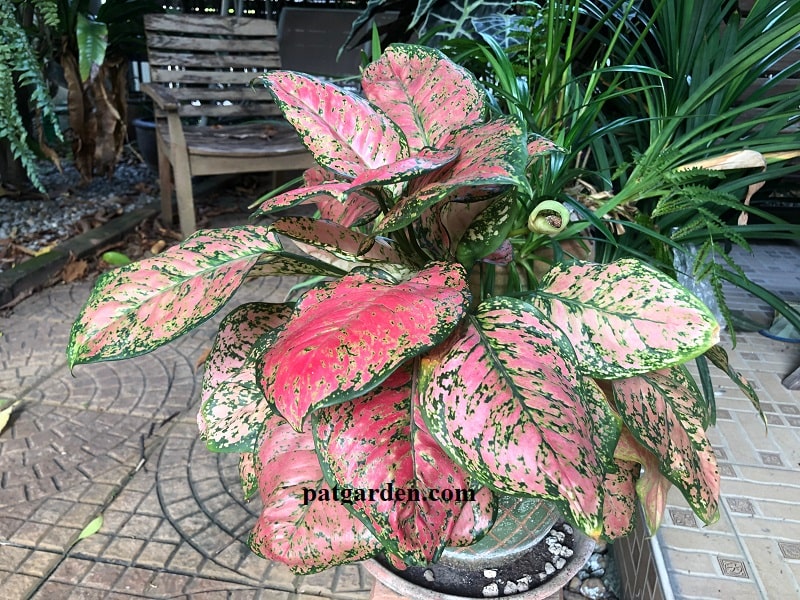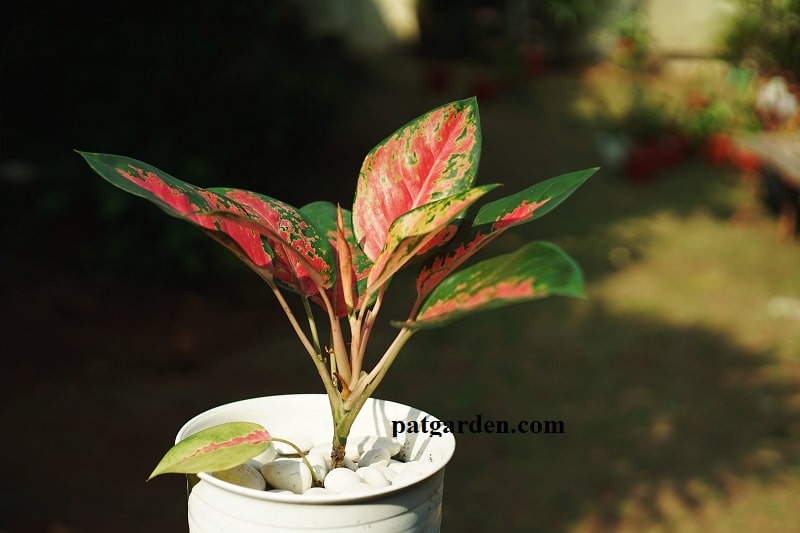I have been growing and caring for my Chinese evergreen (aglaonema) for a decade. My aglaonema has been the happiest houseplant for years. But recently, I have started noticing my Chinese evergreen leaves turning yellow and brown.
So, why are the leaves on my aglaonema turning yellow? Overwatering, low light, pest infestations, aging foliages, and lack of humidity are the reasons for pink Chinese evergreen turning yellow.
I wrote this article to help you identify the exact causes of Chinese evergreen leaves turning yellow. I have also shared hacks for fixing yellow aglaonema leaves without ruining the houseplant structure.

Reasons for Chinese Evergreen (Aglaonema) Turning Yellow
Overwatering Problem
Aglaonema plants thrive well in slightly moist soil. Too much moisture due to overwatering is the possible reason for leaves to turn yellow.
Other symptoms of an overwatered Chinese evergreen are drooping foliages, leaf edema, brown spots, and a rotting smell from the potting soil.
Overwatering problem is due to using poorly draining soil and a pot without drainage holes at the bottom. These two factors will cause sogginess and waterlogged issues.
I recommend watering aglaonema once or twice a week during the spring and summer seasons. It is when this houseplant experiences active growth and utilizes more water.
Be sure to reduce watering frequency when light and temperature levels are low. The houseplant will experience a reduced growth rate in the water and consumes less water.
If you suspect the yellow Chinese evergreen leaves are due to overwatering, inspect the plant for root rot signs. You can do this by uprooting the plant from the pot temporarily.
If root rot is present, remove the houseplant from the pot and trim all the affected roots with a sterilized pruner. Transplant it to fresh and well-draining soil.
If there is no root rot sign, allow the potting soil to dry until the excess moisture evaporates. Ensure there is no dampness to about two inches deep.
Move your Chinese evergreen to a spot receiving bright indirect sunlight and lessen humidity level to speed up the evaporation rate.
Under-Watering Problem
Yellow aglaonema leaves can also be due to inconsistent watering habits. It is easier to identify and fix the under-watering issues.
The yellowing problem occurs on the lower leaves. The aglaonema plant will let these foliages die to favor the younger growth.
You will also notice brown leaf tips and dry edges that feel crispy. The houseplant will later become droopy and look unhappy.
A regular watering schedule is the surest way to save an underwatered Chinese evergreen. Move your aglaonema to a place with moderate temperature and light.
The change will help prevent the potting soil from drying faster. Transplanting the houseplant is another best alternative to prevent the potting mix from drying quickly.
Improper Lighting Condition
Most indoor Chinese evergreens cannot tolerate low lighting conditions. But there are a few aglaonema varieties that can handle low lighting exposure.
Pure green aglaonema species require bright indirect sunlight while the variegated counterparts can handle lower light conditions.
If your pure green Chinese evergreen leaves start turning yellow, it is a sign of low lighting conditions. Move the houseplant to a place that receives bright indirect sunlight.
If your variegated varieties begin to lose their striking colors, it is due to bright indirect sunlight exposure. Relocate the houseplant to a spot that receives low-medium light.
Aglaonema plants do not tolerate direct sunlight exposure. Too much direct sunlight could lead to the Chinese evergreen leaves turning brown. ( University of Florida)
Temperature and Draft
Yellow Chinese evergreen leaves are due to extreme temperatures and drafts. A sudden temperature change can cause your plant considerable stress to result in leaf yellowing.
Aglaonema brown leaf tips and edges are other signs of abrupt temperature changes. Chinese evergreen leaves curling may also be due to extreme temperatures and drafts.
Heaters, air conditioners, and drafty windows are the sources of extreme temperatures and drafts. Keep your plant away from these sources to avoid yellow leaves.
Aglaonema plants prefer a temperature range of 68-77oF (20-27oC). If the temperatures drop below 55oF (13oC), aglaonema leaves turn yellow.
If the temperatures rise above 77oF (27oC), your Chinese evergreen leaves will turn yellow and brown.
Adverse temperatures and drafts are also the reason for Chinese evergreen wilting. Use a digital thermometer to monitor your indoor temperatures.
Transplant Stress
Houseplants experience shock after abrupt relocation. I recommend exercising precaution when uprooting and transplanting ornamental plants.
Aglaonema plants can tolerate the re-potting process. But the leaves may turn yellow and wilt if not done well. Ensure the pot is slightly bigger than the previous one.
Be sure to use a well-draining potting mix. I recommend a mixture of potting soil and perlite. The perlite particles help improve soil drainage.
Yellow aglaonema leaves can be due to root-bound problems. Do not re-pot your Chinese evergreens if there are no signs of root-bound.
Thankfully, Chinese evergreens are slow-growing houseplants. You will see signs of root-bound after many years. Provide ultimate aglaonema care for better growth.
Pest Infestations
All types of aglaonema are vulnerable to insect infestations. These bugs drain nutrients from the houseplant and inject them with venom.
The houseplant will appear sickly and develop yellow leaves. The yellow spots on the leaves are signs of pest problems.
Spider mites, mealybugs, and aphids usually attack Chinese evergreen leaves. These pests can be annoying and deadly to aglaonema plants.
Mealybugs look like tiny cotton balls on the stems and leaves of Chinese evergreens. I recommend isolating the plant from other houseplants to prevent spreading.
Use an insecticidal soap spray to kill pests from your Chinese evergreen. Be sure to exercise patience since getting rid of pests from aglaonema can be a daunting task.
Plant Disease Problem
Chinese evergreens are also vulnerable to bacterial infections. These microscopic diseases tend to cause yellow leaves on Chinese evergreen plants.
Bacterial blight causes large and black blotches on the aglaonema leaves. An overwatered aglaonema will develop yellow leaves due to bacterial blight. (University of Hawaii).
Isolate your aglaonema from other houseplants to prevent spreading bacterial blight. Trim the affected leaves with a sterilized pruner and optimize growing conditions.
Fertilizer Problems
Aglaonema plants are light feeder tropical houseplants due to their slow-growing characteristics. But small doses of liquid fertilizer will help improve the growth rate.
Yellow leaves on the aglaonema plant are a sign of nutrition deficiency. I recommend applying a small dosage of liquid fertilizer or re-pot the houseplant.
Nitrogen deficiency causes yellowing and discoloration on Chinese evergreen leaves. Potassium and phosphorus deficiency will result in mottled leaves with yellow colors.
If you suspect the yellow aglaonema leaves are due to nutritional deficiency, resume feeding schedule. The Chinese evergreen will become vibrant and healthy.
Be sure to feed your aglaonema during the spring and summer seasons. Do not apply fertilizer to the houseplant during winter since it will result in over-fertilization.
Remember to flash the potting mix every three months to leach accumulated salt. Excess salt will result in Chinese evergreen leaves turning brown.
Old Foliages
The natural aging process will cause yellow leaves at the bottom level. The old leaves will fall off and help the plant conserve energy for new growths.
It is normal to see yellow leaves on your Chinese evergreen in the winter and autumn due to a decrease in light conditions. Use artificial lights to resolve the leaf problem.
Frequently Asked Questions
Should I Cut Yellow Leaves off Chinese Evergreen?
No. Pruning Chinese evergreen leaves can kill the entire plant. I recommend letting the yellow aglaonema leaves fall off naturally.
Why Are My Chinese Evergreen Leaves Curling?
Chinese evergreen leaves curl due to excess water loss. Lack of watering due to under-watering and root damage due to overwatering can cause leaves to curl.
Why Is My Chinese Evergreen Dying after Repotting?
Insufficient water supply is the reason behind Chinese evergreen dying after repotting. It can also be due to roots being temporarily unable to absorb water.

Final Word
If you see yellow aglaonema leaves, examine your houseplant closely and think about the ultimate care routine. Overwatering, low light, and pests are the causes of yellow leaves.
Investigate your Chinese evergreen to identify the exact causes. It is much easier to resolve the problem after identifying the cause.
It is normal to see some yellow leaves on aglaonema plants. Keeping this houseplant vibrant and healthy can be tricky for beginners.
I hope this information helped find the reasons for aglaonema leaves turning yellow and brown. Feel free to share with your friends and family.
You May Also Like: